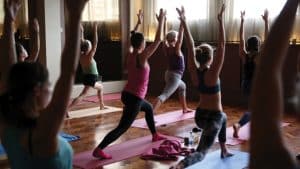Gillian Osborne, vice chair of the British Wheel of Yoga, explains how it can be beneficial for people to get involved, as Clare Vooght reports on the best ways for beginners.

Inews reports that if the idea of attending a yoga class seems intimidating, you’re not alone. Yoga can conjure up images of gravity-defying contortions, ultra-toned women in the latest leggings and men in ponytails doing handstands, plus maybe even a little
chanting. If you’re a wobbly beginner, what could make you more worried of embarrassment?
A study has shown that regular yoga practice is nearly as effective as therapy can be in treating anxiety – prompting renewed calls for
it to be clinically prescribed on the NHS.
Scientists from the Grossman School of Medicine at New York University compared the results of three groups of people with
generalised anxiety disorder, who were treated with cognitive behavioural therapy (CBT), stress-management education and
kundalini yoga.
The CBT group came off best, with scientists noting an improvement in symptoms for 71 per cent of people. But still an impressive 54
per cent of the group that practised yoga had their symptoms improve, compared with 33 per cent of people who learned stress management techniques.
Promising for the NHS?
This isn’t the first call for yoga to be used as a medical treatment. Prince Charles last year said that encouraging people to take part in yoga classes could ease pressure on the NHS because of its therapeutic effects on the body and mind.
The NHS website champions the 5,000-year-old practice for its health benefits, saying that a regular yoga practice can be helpful for those with high blood pressure, heart disease, lower back pain, depression and stress.
Yoga is already socially prescribed on the NHS, meaning doctors can refer patients to services within the community – but clinical
prescribing would mean services would be developed within the NHS.
‘They feel calmer, more balanced and they sleep better’
Gillian Osborne, vice chair of the British Wheel of Yoga (BWY), the governing body for yoga under Sport England, tells i she welcomes
the news findings.
“Yoga is very good at managing anxiety-related disorders. It’s extremely effective at helping people to relax and to gain control of their breathing,” says Osborne, who works with people suffering from PTSD, anxiety, depression and other trauma-related mental health issues.
“Breathing is often something that’s very much impaired in people with anxiety, they often will be subconsciously holding their breath or restricting their breath.”
She explains that with the development of pranayama, techniques to control the breath, “they will begin to experience a less inhibited
breathing rhythm, which will have a beneficial effect on the mind. Generally practitioners will immediately notice improvements in
anxiety. Usually you’ll get people saying they feel calmer, more balanced and they sleep better”.
Osborne uses hatha yoga techniques in her sessions with anxiety sufferers. Hatha is the most common form of yoga in the West, and
the kind of yoga you’ll probably encounter in the average yoga class in sports centres around the UK.
How can people get started?
There are various UK non-profits championing the mental-health benefits of yoga, such as the London-based Blended+, which helps to provide uplifting spaces for the LGBT+ community through yoga and meditation.
And with seven million global subscribers for her Yoga with Adrienne channel on YouTube, Adriene Mishler’s videos prove there’s an
appetite for yoga’s mental health benefits: her Yoga for Anxiety and Stress video has 5.9 million views and counting.
For anyone new to yoga, Osborne says: “Don’t be put off – you don’t need to have Sweaty Betty or Lululemon gear, and you don’t need to be super slim and super flexible, because yoga is suitable for all ages and all abilities.
“I would avoid dynamic practices to begin with and I’d opt for a gentle hatha yoga class with a qualified teacher.”
(Story source: Inews)

